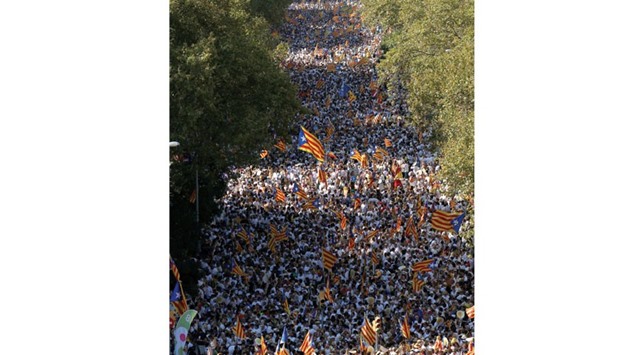Over 340,000 people signed up to join demonstrations for Barcelona and four other cities, scheduled to coincide with Catalonia’s national day, “Diada.”
But the runup to the long-expected protest day coincided with a rift between separatist parties just as they are supposed to launch steps to achieve independence for the wealthy northeastern region in mid-2017.
This year’s Diada is crucial, the head of the regional government of Catalonia, Carles Puigdemont, said on the eve of the rallies.
In the coming months, “decisions will have to be taken that ensure Catalonia can freely choose its path,” he said.
Catalan separatists have tried in vain for years to win approval from Spain’s central government to hold an independence referendum like the one held in 2014 in Scotland in Britain which resulted in a “no” vote.
After winning a clear majority in Catalonia’s regional parliament for the first time ever last year, secessionist parties changed tactics and approved a plan to achieve independence in mid-2017.
But the plan ran into trouble in June when Puigdemont’s coalition government lost the support of the tiny anti-capitalist party CUP which has a hard line on independence.
As a result it lost its clear majority in the assembly.
The pro-independence camp hopes yesterday’s mass protest would reunite and breathe new life into the independence drive, which is moving along more slowly than many of its supporters would like.
Since 2012, major demonstrations in favour of independence have been held in Catalonia every year on its national day on September 11.
The date marks the conquest of Barcelona by Spain’s King Philip V in 1714 after a 13-month siege and the loss of Catalan autonomy.
In 2013, hundreds of thousands of Catalans draped in blue, red and yellow separatist banners held hands in a 400km human chain across the region while in 2014 and 2015 demonstrators held massive rallies in Barcelona, the capital of Catalonia.
The demonstration this year was held in the southern city of Tarragona, in Berga in the centre, Salt in the north and Lleida in the east as well as Barcelona.
Protestors held up yellow cardboard signs to simulate the beating of giant heart.
Among those scheduled to attend are separatist leaders Puigdemont, his vice president, Oriol Junqueras and also Barcelona’s popular mayor, Ada Colau, who is ambiguous about independence,
Her far-left allies, Podemos, are the only large national party which backs a referendum but campaigns against independance.
Colau criticised the “chronic immobilism” of the acting conservative government of Prime Minister Mariano Rajoy when it comes to addressing Catalonia’s concerns.
Catalans have nurtured a separate identity for centuries, but an independence movement surged recently as many became disillusioned with limitations on the autonomy they gained in the late 1970s after the Francisco Franco dictatorship, which had suppressed Catalan nationalism.
Spain’s recent economic downturn exacerbated the situation, leaving many resenting the amount of taxes they pay to the central government in Madrid to subsidise poorer regions.
The central government is unlikely to address these concerns any time soon.
Spain has been without a fully functioning government following two inconclusive general elections in December and June.
Puigdemont faces a confidence vote in the parliament on September 28, just weeks after the planned demonstrations across the region seen as a test of the unity of the separatist drive.
The CUP is willing to back his government again, most likely if he agrees to call an independence referendum in 2017.



